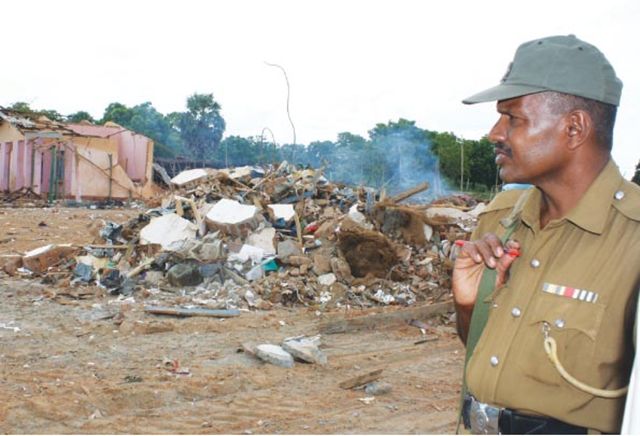
Lashkar-e-Taiba and the Strategy of “Encircling” India
Publication: Terrorism Monitor Volume: 8 Issue: 38
By:

Recent developments in three of India’s neighbors have demonstrated the expanding regional presence, reach and influence of the Pakistan-based Lashkar-e-Taiba (LeT) organization. Going well beyond its Kashmir roots, reports suggest the movement is now establishing a presence in Bangladesh, Nepal and Sri Lanka.
Within a span of six days, Bangladesh authorities arrested four high profile LeT operatives with smuggled exotic dutiable products and large amounts of explosives and other bomb making materials. The detainees included Khurram (a.k.a Mohammad Salem), LeT’s chief coordinator (Daily Star [Dhaka], Oct 05). The latest arrests revealed that LeT operatives use Bangladesh as a transit point for counterfeit currency and as a fertile ground for jihadi recruitment.
India’s Ministry of Home Affairs claimed earlier this month that hundreds of Naxalites (Maoists) from India were being trained in Nepal by Nepal’s People’s Liberation Army (PLA) and supervised by LeT operatives Latif Khan and Razzaq Ansari (Indian Express, October 11). Pushpa Kamal Dahal (a.k.a. Prachanda – “Fierce One”), chairman of Nepal’s Unified Maoists’ Party, suggested the claim was fabricated and formed part of an Indian attempt to disrupt the peace process initiated in 2006 to end a 10-year civil war and the drafting of a new Nepalese constitution. The alert was also condemned as “deliberately erroneous” by PLA Commander Nanda Kishore Pun (a.k.a. Panang) (Telegraph Nepal, October 12, October 13; Indian Express, October 12; Economic Times [New Delhi], October 12). Earlier this year, a detained former LeT financier, Umer Madani, told interrogators that he had been asked to open ties with the Naxalites while based in Nepal but failed to establish any useful ties before his arrest in June 2009 (Indian Express, May 28).
In Sri Lanka, a recent accidental blast of two Chinese containers of dynamite that destroyed the police station they were stored beside raised eyebrows in regional intelligence and security circles (Colombopage.com, September 18; Lanka Daily News, September 18). Though the blast in Karadiyanaru (Eastern Province) had the appearance of an industrial accident (Chinese workers were attempting to move one of the containers at the time), there were unsubstantiated claims that the containers (belonging to a Chinese construction company doing development work in the Eastern Province) were actually scheduled to be transported through Oluvil port to Pakistan and ultimately into the hands of LeT (Lanka News Web, September 29).
Lashkar’s Sri Lanka connection surfaced again in September with the arrest in India of Mirza Himayat Baig, one of the accused in the February 13 German bakery blast in Pune (Maharashtra State). Baig allegedly met fugitive LeT operative Fayaz Kaghzi in Sri Lanka and underwent training in a LeT camp in Colombo. Agencies investigating the German bakery blast confirmed that Baig traveled to Sri Lanka in 2008 and had a meeting with Kaghzi and received money for establishing a new Lashkar network in Udgir (Maharashtra State) (Mumbai Mirror, September 10; see also Terrorism Monitor, March 11). Soon after Baig’s revelation, US intelligence agencies reportedly informed India about existing LeT training facilities and the presence of nearly 200 LeT cadres in Sri Lanka, though this allegation was refuted by Colombo, which firmly denied the existence of any LeT training camps (Indian Express, Sept 19).
This is not the first time U.S. agencies have issued alerts describing a burgeoning LeT clout in South Asia. In his March testimony before the United States Senate Armed Services Committee, Robert Willard, Commander of the U.S. Pacific Command, described LeT‘s expansionist agenda in India’s neighboring countries, especially Sri Lanka and Maldive Islands (Indian Express, March 27).
After executing the 2008 Mumbai attack, LeT was apparently lying low due to increased international pressure on Pakistan to tame rogue Kashmir-centric jihadis. However, within this so-called quiescence period, LeT attempted to regroup and establish new spheres of influence. In early 2010, India’s Mumbai dossier named Pakistani national Rashid Abdullah (a.k.a. Rehan) as a senior LeT commander with special responsibility for leading LeT’s anti-India schemes in the region, including Sri Lanka, Bangladesh, the Maldive Islands, and the United Arab Emirates (UAE).
Though LeT’s attempt to use India’s neighbors as safe havens and launching pads for anti-India activities has been known for some time, the dangerous “encirclement” strategy only came to light in June 2009 with the arrest of Mohammed Omar Madni, the chief of LeT’s Nepal operation and responsible for scouting new talent for LeT operations in Nepal and India, and the mid-2009 arrests of Mufti Obaidullah and Maulana Habibullah, key LeT and Asif Reza Commando Force (ARCF) organizers in Bangladesh. More than establishing bases in Bangladesh or using Nepal as transit point, what is most intriguing is that LeT has managed to infiltrate into Sri Lanka and the Maldive Islands. Eastern Sri Lanka’s Batticaloa district, where the influence of Saudi Wahhabism is most visible (especially in the Kattankudy area), could develop into an operational zone for LeT or like minded jihadi groups. The circumstances of the blasts in nearby Karadiyanaru are still shrouded in mystery, but the confession of Mirza Baig gives credence to the belief that LeT has established at least a network of facilitators in the island nation.
If the confession of Sabahuddin Ahmed, accused in the Mumbai attacks (but acquitted for lack of evidence), is to be believed, a Maldivian named Ali Ahsham did the reconnaissance on targets in Bangalore before the December 2005 attack on the Indian Institute of Sciences (Times of India, February 4). In Maldives too, LeT’s charitable front, Idara Khidmat-e-Khalq (IKK), which operated in the aftermath of the 2004 tsunami under the guise of providing humanitarian assistance, has successfully influenced youths to join the so-called jihadi struggle and turn Maldives into a jihadi recruiting ground (see Terrorism Monitor, February 14).
Both Sri Lanka’s defense secretary Gotabaya Rajapaksa and Maldivian president Mohamed Nasheed denied that Lashkar-e-Taiba is using their countries’ soil as a base to perpetrate future attacks on India. However, they promised further investigations and Naseed acknowledged the fact that some Islamist radical groups have emerged recently in the Maldives.
The larger concern here lies in the strategic positioning of LeT vis-à-vis India. However, the denials aside, looking at the pace of LeT ventures into the countries in South Asia, the day may not be far when LeT could establish itself as a formidable non-state terror hegemon, perhaps even overtaking al-Qaeda.
Animesh Roul is the Executive Director of Research at the New Delhi-based Society for the Study of Peace and Conflict (SSPC).





